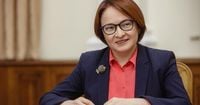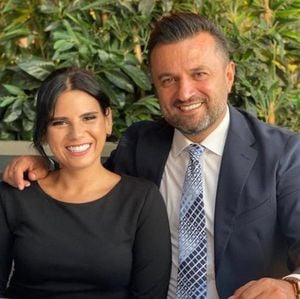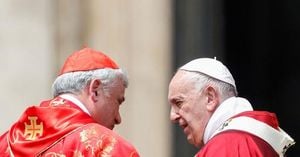On April 25, 2025, the Central Bank of Russia maintained its key interest rate at a record level of 21% for the fourth consecutive time. Elvira Nabiullina, the head of the Central Bank, emphasized that this high key rate serves as an "effective medicine" to combat overheating demand in the economy.
During a briefing following the Board of Directors meeting, Nabiullina noted that the likelihood of a new round of rate hikes has decreased compared to previous meetings. She stated, "If you look at our forecast for the key rate this year, you will see that both a decrease and an increase in the rate are possible. However, we believe that the probability of an increase has decreased compared to the last meeting."
Despite the potential for inflation to decline, Nabiullina reiterated that the Central Bank intends to maintain tight monetary conditions for as long as necessary to meet inflation targets. "We need to maintain strict monetary conditions for a long time. Even if inflation expectations decrease, tight monetary conditions in real terms will still be preserved," she emphasized.
Nabiullina also pointed out that the slowdown in inflation is uneven across the consumer basket. In March 2025, the price growth for non-essential goods fell below 2% on an annual basis, while essential goods and services saw a more modest decrease, remaining close to 10%. She explained, "This discrepancy in figures can be attributed to the fact that prices respond to changes in the key rate in different segments of the consumer market with varying lags."
Prices for non-essential goods tend to react more swiftly to changes in the key rate than those for services and food, primarily because durable goods are often purchased on credit. As a result of high interest rates, the volume of loans has decreased, leading to reduced demand and consequently slower price growth for non-essential goods.
Conversely, demand for services and essential goods is primarily influenced by income dynamics, which have been growing in recent years. Nabiullina noted, "Since significant deceleration in price growth is not occurring across the entire range of goods and services, we cannot yet conclude about the sustainability of the overall slowing rate of price growth. As demand cools, the gap in price dynamics between different goods and services will narrow."
Looking at the broader economic picture, Nabiullina indicated that while GDP continues to grow, it is doing so at a more moderate pace. Consumer growth has slowed following a brief acceleration in January, and investment activity remains near the high levels of the previous year. However, a shortage of skilled labor continues to limit investment growth.
Nabiullina stated, "There are signs of easing tension in the labor market according to our surveys." Monetary conditions have not changed significantly, maintaining the tightness necessary to curb inflation. She noted that the curves of the money market and government bonds have shifted upwards since the last meeting, largely due to market expectations of a higher trajectory for the key rate.
Operational data from March revealed a slight decrease in both deposit and credit rates. Nabiullina explained, "It is important to note that we not only look at nominal rates, but also analyze them with adjustments for inflation expectations. In the first quarter, both nominal rates and inflation expectations decreased, yet price conditions did not significantly change."
Credit activity in March remained subdued, with mortgage and corporate lending experiencing slight increases, while unsecured retail lending saw a decline. Nabiullina also commented on budget expenditures, stating that they approximated seasonal norms in March and that the dynamics of the money supply have slowed, aligning with the goal of returning inflation to 4%.
In terms of external conditions, Nabiullina highlighted the reassessment of import tariffs in major economies, which has led the Central Bank to lower its growth forecast for the global economy. She remarked, "We have lowered the export forecast, and the dynamics of imports will also be subdued due to tight monetary policy."
Regarding risks, Nabiullina identified a potential greater slowdown in the global economy due to trade wars, along with risks stemming from the labor market and inflation expectations. "Disinflationary risks have not significantly changed compared to the last meeting. Our baseline scenario still assumes a return to budgetary rules from this year, which means a budgetary contribution to disinflation," she stated.
She also highlighted the importance of maintaining strict monetary conditions for an extended period, which is reflected in the forecast for the average key rate this year, projected to range between 19.5% and 21.5%. Nabiullina concluded, "A high level of the key rate will ensure a slowdown in the current pace of price growth to 4% by the end of this year and will allow us to anchor inflation at 4% in the future."
As for the public’s expectations, Nabiullina noted that people often anticipate high inflation and stock up in advance, necessitating a stringent monetary policy. She stated, "This tight monetary policy curbs demand for imports and increases the attractiveness of ruble assets, contributing to the ruble's strengthening in the first quarter, which also reduced price pressure."
Looking ahead, Nabiullina predicted that the peak in annual inflation is expected in May, followed by a slowdown, although a slight increase in inflation levels could occur in July due to the indexation of housing and communal services tariffs.
In her remarks, Nabiullina stressed that low inflation is essential for the development of the economy, stating, "4% is the upper limit of what can be considered price stability. In the future, the target value may change, but we believe it should only move in the direction of reduction." She warned that if inflation in Russia remains significantly higher than in other countries, the ruble will inevitably weaken.
Ultimately, Nabiullina's insights reflect a cautious yet determined approach to managing inflation and ensuring economic stability in Russia as the country navigates complex global economic challenges.




